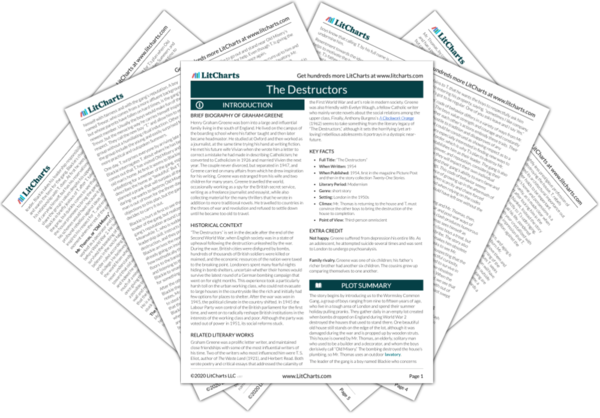The members of the Wormsley Common Gang are boys ranging in age from nine to fifteen years old. Mike is still a child, while T. and Blackie are just a few years into their teens. As such, there is little surprise in the boys’ rebellious antics. They have little respect for the world around them – a world blown apart by a war that shaped their society but which they don’t remember – and so in search of fun and fame from rival gangs they pull pranks such as stealing rides on buses. The boys’ rebellions are general and undirected and, for a young boy like Mike, even the destruction of Mr. Thomas’s house is just another prank to carry out with gusto.
In the character of T., though, the story explores a different, more pointed sort of rebellion. In the past, both T.’s father and Mr. Thomas worked to build houses – T.’s father as an architect, and Mr. Thomas in the slightly less prestigious profession of builder and decorator. By destroying the house, T. rebels against his father, who pointed its architectural importance out to T., and against what his father holds to be important. Although destroying an old man’s home and possessions is a cruel act, T. is not motivated by cruelty, as is made clear when he thinks of Mr. Thomas’s comfort after locking him in the lavatory and brings him food and a blanket. Instead the story ties the plan to destroy the house directly to T.’s upbringing, describing it as having “been with him all his life, pondered through the seasons, now in his fifteenth year crystallized with the pain of puberty.” This strengthens the impression that T. sees destroying the house as an act of rebellion against the world of his family.
The connection between rebellion, adolescence, and aging is clearly drawn in the scene when T. and Blackie burn Mr. Thomas’s life savings and “the grey ash floated above them and fell on their heads like age.” This image ties the burning of the money directly to the gray-haired elders whose values T. seeks to flout. And yet it also implies that this act of rebellion will have an impact on the boys themselves. Although it happens outside the confines of the story, Blackie, T. and the rest of the gang are also, inevitably, growing older themselves. There may come a day when they realize the monstrousness of their act towards a weak, elderly man. There may even come a day when they themselves are old, and the things that they have built or cherished are dismissed and destroyed by a younger generation.
The story also employs shifts in perspective to deepen its portrayal of youthful rebellion. When Mr. Thomas is locked in the lavatory, the story is told from his perspective. He feels “dithery and confused and old,” sitting on the lavatory “loo” and contemplating his situation “with the wisdom of age.” The image of Mr. Thomas sitting on the toilet seems to mock the “the wisdom of age” as nothing more than the realization that one can do little to change the world (or even to escape a locked lavatory). Simultaneously though, the image shows us how cruel what the boys are doing to Mr. Thomas is. With the energy of youth, they cannot fathom Mr. Thomas’s discomfort as he sits in a damp, cold lavatory, nor do they consider the horrible injury they are doing him by destroying all that he has left in the world. Yet in its final scene the story shifts to track the actions of the adult lorry driver, who inadvertently pulls down Mr. Thomas’s house and then laughs despite Mr. Thomas’s obvious distress. This cruel laughter is shocking, but also shows that the British society portrayed in the story is itself going through a kind of adolescence, moving away from the rules that governed it in the past, but still lacking a clear moral compass and sense of right and wrong.
Adolescence, Age, and Rebellion ThemeTracker

Adolescence, Age, and Rebellion Quotes in The Destructors
T. was giving his orders with decision: it was as though this plan had been with him all his life, pondered through the seasons, now in his fifteenth year crystallized with the pain of puberty.
'Of course I don't hate him,' T. said. 'There'd be no fun if I hated him.' The last burning note illuminated his brooding face. 'All this hate and love,' he said,' it's soft, it’s hooey. There's only things, Blackie,' and he looked round the room crowded with the unfamiliar shadows of half things, broken things, former things. 'I’ll race you home, Blackie,' he said.
He said to the boy beside him, 'I'm not unreasonable. Been a boy myself. As long as things are done regular. I don't mind you playing round the place Saturday mornings. Sometimes I like company. Only it's got to be regular. One of you asks leave and I say Yes. Sometimes I'll say No. Won't feel like it. And you come in at the front door and out at the back. No garden walls.'
















